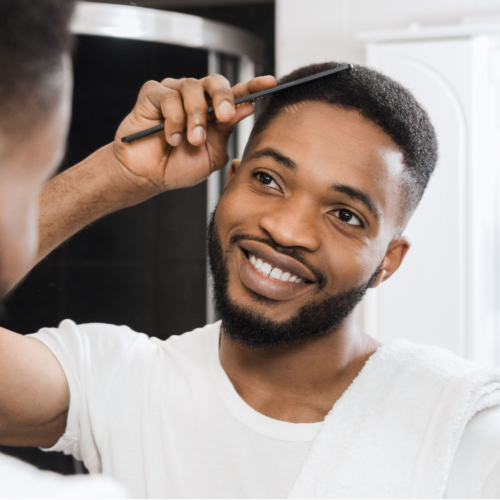Causes of African American Hair Loss
Hair loss can be due to several factors, including male pattern baldness, thyroid issues, polycystic ovarian syndrome (PCOS), and more. Additionally, chemical relaxers, weaves, or protective hairstyles like braids or twists that are done too tightly can cause what’s called traction alopecia.
Traction alopecia is caused by repeated pulling on the hair that sometimes occurs throughout the styling process. Over time, the hair follicles can be damaged by tugging, resulting in thinning or balding spots.
Symptoms of traction alopecia can include:
- Small bumps on the scalp
- Tenderness
- Crusting
- A stinging sensation
Why Choose The Hair Transplant Center – New Jersey
Dr. Dominick Golio is the cosmetic surgeon of choice for celebrity actors and pro athletes. With over 20 years of cosmetic surgery experience, he has helped patients with many different backgrounds find hair loss solutions, including African Americans.
Dr. Golio uses cutting-edge technology like wireless Follicular Unit Extraction (FUE) that’s particularly beneficial for those with curly or wavy hair. When you’re ready to transform your hair, choose The Hair Transplant Center – New Jersey.
We pride ourselves on honest transparency, so you’ll leave our office knowing exactly what to expect and how much you’ll pay. No gimmicks, no hidden fees.
Our Methods for African American Hair Transplants
The Hair Transplant Center – New Jersey specializes in two hair transplantation methods: Follicular Unit Extraction (FUE) and Follicular Unit Transplantation (FUT). Our hair surgeons will work with you to determine the best transplantation method for your hair’s texture, depending on your hair loss pattern and desired results.
FUE Transplants
FUE transplants are hair restoration procedures that extract individual hair follicles from donor sites on your head. These follicles are transplanted into areas where you’re experiencing balding or thinning hair. Additionally, with the evolution of wireless technology, FUE hair transplant tools are now even more precise, improving results with curly hair.
FUT Transplants
FUT transplants require the hair surgeon to remove an entire strip of hair from the back of your head. This method is faster, as you can harvest more follicles at once, but it does leave visible scarring.
How our African American Hair Restoration Process Works
Hair Loss Consultation
The first step before any procedure is to have a consultation with your hair surgeon, where you’ll discuss any concerns or aesthetic goals you may have. After thoroughly evaluating your hair, we’ll recommend the right hair restoration procedure for you and begin outlining your hairline.
Hair Restoration Cosmetic Procedure
FUE Procedure
FUE is a hair transplant procedure that removes individual healthy hair follicles from donor sites on your head and transplants them into the areas of the scalp where you’re experiencing hair loss. Your hair surgeon will use a very small tool to extract each follicle, which is ideal for short hairstyles as it leaves minimal to no scarring.
FUT Procedure
FUT transplants require the hair surgeon to remove a strip of healthy hair follicles from the back of your head. This method is the most traditional form of hair transplantation, but it also leaves a linear scar. FUT can be an excellent option for those with longer hair that easily disguises the scarring.
Recovery and Results
FUE Recovery
The FUE procedure can last anywhere from two to four hours, depending on how many hair grafts you need, but recovery is fairly quick. Within two to three days, you can return to your normal activities. That said, we recommend avoiding strenuous exercise until seven to ten days after your procedure.
While there will be hair loss initially, new hair growth will start to be visible within three to four months. After a year, you can expect to see full growth. The great news is that while you may experience some graying or thinning hair as you age, your results should last the lifetime of your regular hair.
FUT Recovery
FUT recovery can be slightly more involved than FUE, with recovery time lasting anywhere from ten to 12 days. You may experience some itchiness or discomfort at the incision site, but our hair transplant surgeons can prescribe pain medication to help alleviate any pain.
The recovery time may be longer, but the FUT method is still a popular hair restoration solution for those with longer hair. FUT allows your hair surgeon to harvest more hair faster, reducing the procedural time.

